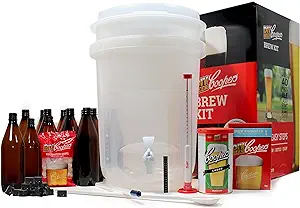How to make great tasting beer at home.
One of the easiest and most rewarding DIY projects ever is Cooper’s DIY beer kit. Everything you need to make your own great tasting beer is all in your brew kit box, but even if you’ve had a few DIY disasters in the past just follow the simple instructions and you’re sure to make great tasting beer.
Let’s take you through getting prepared, cleaning the equipment, mixing the ingredients adding the yeast the fermentation period testing bottling and then enjoying your beer.
Let’s get into it.
Ingredients
Start to gather all the ingredients necessary for your chosen style of brew. Pay particular attention to ingredient best before dates – the fresher the better. Only use water that is free of chlorine odor and is acceptable for drinking.
The most common cause for brews to fail is contamination – so all equipment that comes in contact with the brew must be cleaned to remove all visible solids. Make sure the tap is removed, disassembled, and cleaned – once the equipment looks clean it should be sanitized with a chemical sanitizer such as Cooper’s sanitizer or a non-scented household bleach. The first time you use your kit you can just rinse it in hot water, just remember whenever you are cleaning your equipment only use a soft cloth that won’t scratch it.
Once everything is clean you can connect your tap, put on your thermometer strip and you are ready to go.
Mixing
To prepare your mix, first remove the label from the brew can and standard
inverted in hot tap water for 10 minutes or so to soften it, we invert it because
that’s the end we’ll be opening while the cans warming. Pour dry ingredients into
the fermenting vessel and add 2 liters of hot water to dissolve. Once the brew
can is ready, grab it with a tea towel, open it, pour it in and mix thoroughly. Then add water to the 20-liter mark, give it a stir and check the brew temperature – get the brew temperature in a 21 to27 degrees Celsius range. Top-up to the
23-liter mark with cold or hot water as required, getting the temperature right is
important so you might want to do a wet run without ingredients first.
At this stage you might see some particles floating in your brew but don’t worry, we call this cold break and it’s totally normal.
Now it’s time to add the yeast.
Add Yeast
Adding Yeast – first fit the Krausen, then sprinkle the dry yeast evenly over the
surface and place the lid on even if the temperature is slightly outside the
recommended range. It’s important to get the yeast in as soon as possible.
Next measure the specific gravity of your brew – to do this you’ll need your
hydrometer start by drawing the brew from the tap to half fill the sample
tube and then discard this first sample. Then draw another sample with enough
brew to float the hydrometer, read the gravity scale at the meniscus of the
brew and record.
Now we wait while the brew ferments, just make sure it stays within the recommended temperature range.
Fermentation
After 12 to 24 hours, you’ll know that fermentation is underway in your Coopers DIY kit because you’ll see foam beginning to occur and the brew becoming cloudy. All you need to do is make sure the temperature is consistent and leave it for a few days.
On day 3 of fermentation or when the foam has subsided, removed the Krausen kollar for
cleaning and replace the lid. It’s fine to put your Krausen kollar in the dishwasher. On day 6, draw another sample out and measure the specific gravity
Again. If your sample is too foamy you may need to de-gas it.
Test the specific gravity each day until final gravity is stable two days in a row. This means your brew is ready to bottle at this point and we recommend you try your brew to check if it tastes and smells okay. If all checks out then you’re good to go to bottle your home brew.
Bottling
Fit your bottling valve just slip it inside the tap, now you can easily fill your bottles without having to keep turning the tap on and off. If there’s too much foam while bottling, just back the tap off a bit.
It’s also a good idea to place a container under the bottling valve to catch any drips. Once filled, prime your bottles at the rate of 8 grams per liter, that’s two carbonation drops for every 750 ml bottle. Store the bottles at or above 18 degrees Celsius to allow the secondary fermentation to take place.
Storage
After a couple of weeks, you can stick your bottles in the fridge to get them nice and frosty, then sit back and enjoy your Cooper’s DIY beer.

See – homebrewing beer can be pretty easy – Cheers!